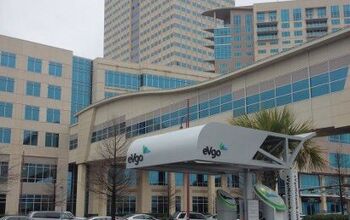QOTD: Range Anxiety

Hyundai announced today that the maximum range in the Ioniq6 will be a tick over 360 miles.
Not bad!
Range anxiety has always been a concern with EVs, but we're reaching a point where EVs can get over 300 miles to a charge -- this Hyundai isn't the only one. It wasn't that long ago when 300 miles was pretty good for an internal-combustion-engine vehicle.
Of course, technology advances, and now most ICE cars, crossovers, and trucks get more than 400 miles of range. That's usually because cars are simply more fuel-efficient now -- though sometimes it's a function of a large tank. That latter bit tends to happen with gas-guzzling large trucks -- it is possible for a vehicle with poor MPGs to achieve a decent fuel range if the tank is big enough.
The few ICE vehicles I test now that have a range under 300 miles are dedicated sports cars and cars with tiny tanks. That said, 300 miles still would give me, if I had an average commute of 40 miles per day, seven and a half days of driving before I needed to refuel. Or in the case of an EV, seven and a half days before needing to recharge. Yes, yes, I am simplifying things here -- no one is driving exactly 40 miles a day each day, I'm not factoring in weekends or non-commuting trips, and I'm not factoring in the effect that weather and driving style have on EV range -- but the point is, 300 miles of range means you won't need to worry about charging on the daily.
To be fair, most EVs aren't yet at 300. All-wheel drive seems to sap range, and in some cases, one must fork over more dough for a battery pack that can provide more range. Right now, ranges of 200-250 miles are more common, and having even 50 fewer miles available to you can make a difference.
This leads, after this long preamble, to my question to you -- what range, be it fuel or EV charge, would make you the most comfortable? Even when driving an ICE vehicle, I find myself eyeing the gauge a lot more when the max range is under 300. Even when gas is cheap -- and even when I can expense it. Same with EVs -- I was more relaxed testing the Mercedes-Benz EQS than I have been with other EVs because I knew the range was over 300 miles.
What say you? Sound off below.
[Image: Southworks/Shutterstock.com]
Become a TTAC insider. Get the latest news, features, TTAC takes, and everything else that gets to the truth about cars first by subscribing to our newsletter.

Tim Healey grew up around the auto-parts business and has always had a love for cars — his parents joke his first word was “‘Vette”. Despite this, he wanted to pursue a career in sports writing but he ended up falling semi-accidentally into the automotive-journalism industry, first at Consumer Guide Automotive and later at Web2Carz.com. He also worked as an industry analyst at Mintel Group and freelanced for About.com, CarFax, Vehix.com, High Gear Media, Torque News, FutureCar.com, Cars.com, among others, and of course Vertical Scope sites such as AutoGuide.com, Off-Road.com, and HybridCars.com. He’s an urbanite and as such, doesn’t need a daily driver, but if he had one, it would be compact, sporty, and have a manual transmission.
More by Tim Healey
Latest Car Reviews
Read moreLatest Product Reviews
Read moreRecent Comments
- MaintenanceCosts 308/311 is just the rating of the gas engine by itself. The full powertrain power rating, taking into account both power sources is 483/479. The car will do 0-60 in under five seconds. Frankly, I find the idea of that being "underpowered" bizarre.Also, "understated" has never been less fashionable within my lifetime. We are in a moment where everyone wants to make a Bold Statement with everything they do.
- 28-Cars-Later @PoskySo here's some interesting data, Manheim's Used Car index is still 28% higher than shortly before the Plandemic (155 on chart) after declining from a height of 39% (roughly 215) in January 2022, yet interest rates are now more than double on average. Maybe the White House should focus on some deflationomics instead of mucking up everything?
- Dale Had one. The only car I ever bought because of a review in a guitar magazine.Sure was roomy inside for such a small car. Super practical. Not much fun to drive even with a manual.Sent it to college with my stepson where it got sideswiped. Later he traded it in on an F-150.
- Bd2 Hyundai's designs are indeed among the most innovative and their battery technologies should allow class leading fuel consumption. Smartstream hybrids are extremely reliable.
- 28-Cars-Later So now H/K motors will last longer in between scheduled replacements. Wow, actual progress.


































Comments
Join the conversation
Wrong question, for a lot of people even a PHEV has enough range for commute or errands. The problem is lack of a cost effective, speedy and available charging infrastructure. With an ICE you're usually never more than a few miles away from a ten minute fill up. THAT is what makes me comfortable on a cross country trip. Electrics can manage more routes than many people realize but you have to plan it out and allow for charging times and pray charging stations are real and working shopping the way. It's a few years out yet.
True anyone who tops off nightly has plenty of range for their commute, that's not the point. Tesla's proprietary network is an asset but moot for the majority that doesn't plan to buy a Tesla. And to the previous comment's point, charging stations aren't ubiquitous. When fast charging becomes as quick, as cheap and as readily available as gas stations an electric will be viable as an only car in the garage.